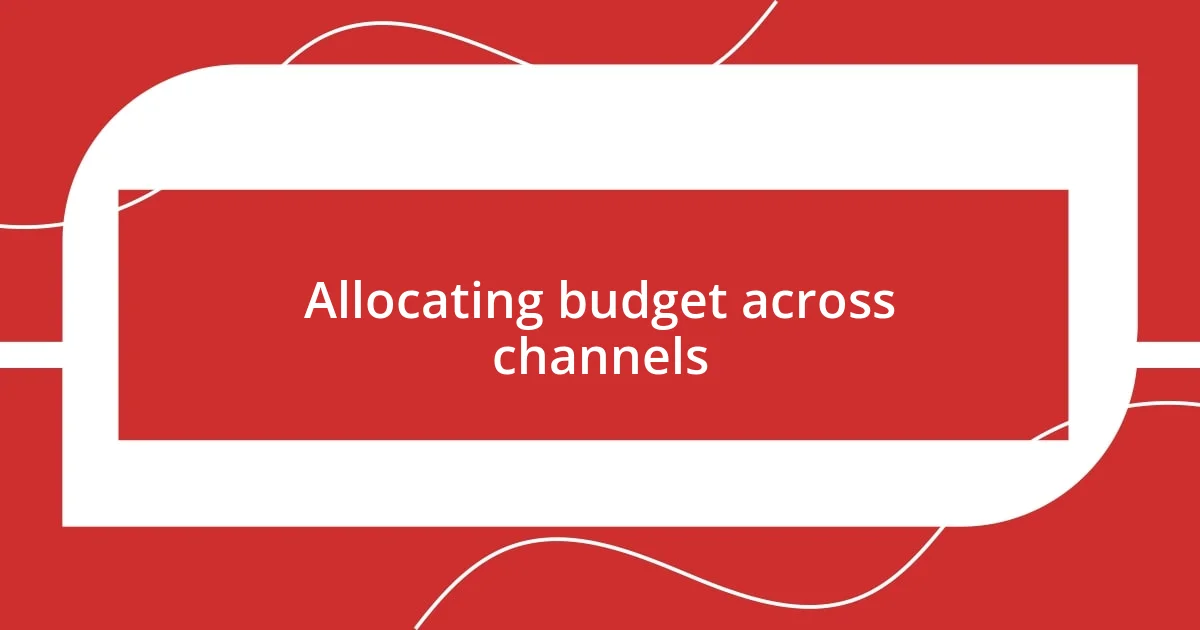Key takeaways:
- Understanding and setting clear advertising budgets and goals is crucial for effective marketing strategy and successful execution.
- Regular analysis of past advertising performance and metrics helps to identify audience behaviors and inform future spending decisions.
- Flexibility in budget allocation and continuous tracking of expenses allows for real-time adjustments, optimizing ROI and enhancing overall campaign effectiveness.

Understanding advertising budgets
Understanding advertising budgets starts with recognizing that they’re not just numbers on a spreadsheet; they’re a roadmap for your marketing strategy. I remember when I first began managing a budget and felt overwhelmed by the intricacies. Would I allocate too much to one channel and miss out on a hidden gem in another? Finding that balance became a pivotal lesson for me.
When I first established my budget, I divided it into fixed and variable costs, which helped demystify spending. Fixed costs are pretty straightforward—these are your essentials, like creative materials or software subscriptions. The variable costs, however, felt like a moving target! Every change in focus could shift my spending dramatically. Have you ever felt that thrill of seeing a campaign take off, while also worrying about overspending in the process?
Ultimately, understanding advertising budgets means being flexible and open to adjustments. I learned to monitor performance in real-time, which often meant making tough decisions on the fly. Trust me, it’s not just about sticking to the initial number; it’s about responding to what works and what doesn’t as the landscape shifts. Do you remember a time when a small tweak in your strategy led to unexpectedly high returns? That’s the beauty of a well-managed budget.

Setting clear advertising goals
Setting clear advertising goals is essential for steering any budget effectively. I still recall a campaign where we increased brand awareness, but without a focused goal, it felt like we were floundering. The lack of a specific target made it challenging to measure our success. My epiphany came when I started using the SMART criteria—making goals Specific, Measurable, Achievable, Relevant, and Time-bound. This framework not only clarified our focus but also boosted team morale since everyone knew their roles and targets.
To set clear advertising goals, consider the following elements:
- Identify Your Purpose: Determine what you want to achieve—brand awareness, lead generation, or customer retention.
- Be Specific: Instead of saying “increase sales,” aim for “boost online sales by 20% in three months.”
- Timeframe Matters: Set deadlines to keep your team accountable and motivated.
- Align with Overall Strategy: Make sure your advertising goals align with your broader business objectives.
- Review and Adjust: Regularly revisit your goals to ensure they remain relevant and achievable.
Establishing these clear goals turned what once felt chaotic into a structured process that directly influenced our advertising success. If there’s one thing I’ve learned, it’s that clarity actually liberates creativity; a well-defined goal allows for more innovative thinking around execution.

Analyzing past advertising performance
Analyzing past advertising performance is one of the most eye-opening parts of budget management. It often reveals patterns I hadn’t initially considered. I distinctly remember reviewing a campaign where we spent heavily on social media ads, only to find that email marketing delivered far better ROI. Asking questions about why certain channels succeeded while others floundered is essential. What did I learn from this? Each campaign is a lesson in understanding audience preferences and behaviors.
During my analysis, I learned to look beyond click-through rates and conversions. I began considering the overall customer journey and how various touchpoints influenced conversions. For instance, have you ever tracked how interactions with our brand on social media influenced email sign-ups? I was surprised to see that some seemingly less impactful channels played a significant role in nurturing leads. Establishing a comprehensive picture of performance has been crucial in refining my approach.
There are various metrics to analyze when looking back on advertising performance. Here’s a concise comparison table to help you visualize them:
| Metric | Purpose |
|---|---|
| Click-Through Rate (CTR) | Measures the efficiency of ads in generating interest. |
| Return on Investment (ROI) | Assesses the profitability of advertising efforts. |
| Conversion Rate | Tracks the effectiveness of turning leads into customers. |
| Engagement Rate | Evaluates how well your audience interacts with the content. |
By delving into these metrics, I’ve found that analyzing past advertising performance not only informs future budgeting but also helps me understand my audience more deeply. It’s an ongoing process, but with each analysis, I feel more equipped to make confident decisions. How did your past experiences shape your understanding of these metrics? It’s an amazing journey of growth, isn’t it?

Allocating budget across channels
When it comes to allocating a budget across different advertising channels, I can’t stress enough the importance of identifying which platforms resonate most with your audience. There was a time when I split my budget equally across channels, thinking a broad approach would yield results. However, it didn’t take long before I realized that was a misplaced assumption. A deep-dive analytics phase revealed that a significant portion of our target demographic was more engaged on Instagram than on display ads. This insight allowed me to redirect funds and amplify our presence on a channel where it truly mattered.
I also learned that flexibility is crucial in budget allocation. Each month, I would review performance data closely, adjusting the budget based on what was driving conversions. For instance, when our video ads outperformed expectations one month, I quickly shifted funds from less effective campaigns. Have you ever had that lightbulb moment when you realize you can pivot your strategy based on real-time data? It can be incredibly empowering. Ultimately, it’s all about staying agile and responsive to results, ensuring that every dollar spent is contributing to your overarching goals.
Furthermore, understanding the synergy between different channels can lead to even better results. I once ran a campaign where we strategically aligned our social media efforts with email marketing, creating a loop of engagement. It became clear that the more we promoted our email content on social platforms, the higher our open rates soared. Has your experience shown you the impact of integrated marketing like this? I find that it not only optimizes budget use but also enhances brand consistency across touchpoints, which is vital for maintaining a cohesive message.

Optimizing budget for maximum ROI
Finding the right balance in budget optimization is like trying to solve a puzzle. I once had a campaign where I allocated a significant portion to high-cost ad placements, expecting big returns. However, after careful tracking, I noticed that our lower-cost strategies, such as targeted retargeting ads, brought in a much higher ROI. This insight shifted my perspective entirely. It made me realize that sometimes, less is more. Have you ever experienced a similar revelation where a simple tweak turned your entire strategy around?
Another key aspect of optimizing my budget was testing and iteration. Early on, I was hesitant to experiment with my spend. But I learned the power of A/B testing campaigns, where I could directly compare different approaches. One instance stands out; I tested two variations of an ad with different visuals. To my surprise, a simpler, more relatable image led to significantly better engagement. It taught me that understanding audience preferences isn’t always straightforward and sometimes, the boldest choices can yield the best outcomes. Have you found that embracing experimentation has benefited your advertising strategies?
Finally, aligning my spending with specific goals has been crucial for maximizing ROI. I recall a time when I set a clear objective for a campaign focused on brand awareness, only to realize that my budget allocation was heavily skewed towards conversion-focused ads. Once I realigned my strategy and tailored my messaging, I started to see both brand engagement and sales increase. It underscored this important principle: clarity in objectives not only guides budget decisions but also creates a sense of purpose in every ad dollar spent. How do you ensure your advertising efforts align with your overall business goals? It’s essential for sustaining growth.

Tracking advertising expenses effectively
Tracking advertising expenses effectively is key to making sure every dollar counts. In my experience, using robust tracking tools has made a invaluable difference. I remember implementing a spreadsheet system combined with automated analytics from our ad platforms. Suddenly, I could see, at a glance, exactly where each dollar was going and how campaigns were performing. Do you have a tracking system in place that gives you this level of clarity? If not, I highly recommend it.
Along the way, I learned the importance of categorizing expenses. Initially, I lumped all my costs together, which made it hard to pinpoint opportunities for improvement. By breaking down categories—like creative costs, media buys, and agency fees—I gained insights that transformed my approach. For example, identifying how much was spent on creative versus actual media helped me make more informed choices. Have you found that granular tracking opens up new avenues for optimizing your budget?
Regularly reviewing my advertising expenses has become a habit that I can’t live without. I set aside time each week to assess performance against my budget. One memorable moment was when I discovered a campaign consistently underperforming; by redirecting its funds, I unlocked opportunities in a high-performing area that had previously been underfunded. It was a game changer! I genuinely believe that consistent tracking not only highlights inefficiencies but also inspires informed decision-making. How often do you check in on your advertising expenses? Making this a routine can lead to impressive adjustments and outcomes.

Adjusting budget based on performance
Adjusting my advertising budget based on performance has been a transformative experience. For instance, I vividly recall a project where I initially allocated funds to a broad audience, only to find out from the data that a specific niche was responding far better. Reallocating my budget to focus on that high-performing segment resulted in a noticeable lift in engagement and conversions. Have you ever had that moment where the numbers told a story you weren’t expecting?
I’ve also learned that performance insights aren’t static; they change over time. There was a campaign that started strong but gradually lost steam. Instead of sticking to the original plan, I decided to pull back and reallocate those funds to a fresh campaign that had just shown promising early results. That shift was crucial, and it reinforced my belief that I must always keep my finger on the pulse of my campaigns. Do you regularly revisit your budget allocations to stay responsive to performance shifts?
One of my greatest learnings was to embrace flexibility in my budgeting approach. I remember a particular month when an ad set was dramatically outperforming others. By quickly diverting more funds into that area, I could amplify its success before it plateaued. This adaptability not only nurtured my creative instincts but also kept me engaged with the real-time metrics. How do you allow room for flexibility in your budgeting? Embracing a dynamic approach can unlock significant potential for your campaigns.















